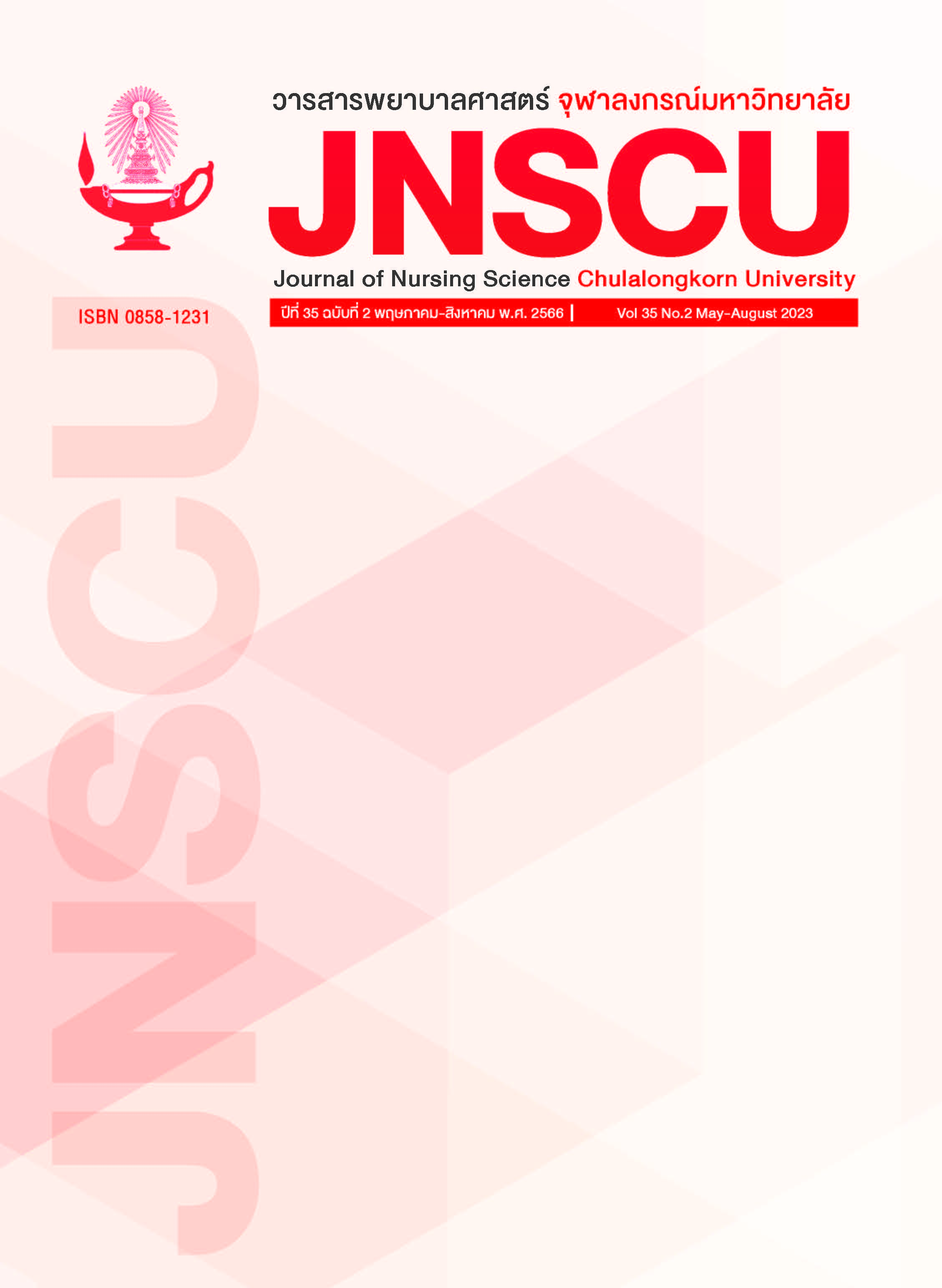กระบวนการและผลลัพธ์การจัดการความปวดในผู้ป่วยหลังผ่าตัดศัลยกรรมจักษุในโรงพยาบาลเมตตาประชารักษ์ (วัดไร่ขิง)
คำสำคัญ:
ปวด, การจัดการความปวด, ผ่าตัดจักษุ, ผลลัพธ์การจัดการความปวดบทคัดย่อ
วัตถุประสงค์: เพื่อศึกษากระบวนการและผลลัพธ์การจัดการความปวดของผู้ป่วยที่ได้รับการผ่าตัดศัลยกรรมจักษุหลังผ่าตัดศัลยกรรมจักษุ 24, 48 และ 72 ชั่วโมง
รูปแบบการวิจัย: การวิจัยย้อนหลังเชิงพรรณนา
วิธีดำเนินการวิจัย: ศึกษาเวชระเบียนย้อนหลัง 3 ปี ตั้งแต่ พ.ศ 2562-2564 จำนวน 80 ราย ในผู้ป่วยที่มารับการผ่าตัดศัลยกรรมจักษุ โดยการสุ่มแบบเจาะจง รวบรวมข้อมูลโดยแบบบันทึกข้อมูล ประกอบด้วย ข้อมูลส่วนบุคคลและด้านสุขภาพ ผลลัพธ์การจัดการความปวด และกระบวนการจัดการความปวด เครื่องมือการวิจัยครั้งนี้ผ่านการตรวจสอบความตรงตามเนื้อหาจากผู้ทรงวุฒิ ทั้งหมด 3 ท่าน ได้ค่าความตรงตามเนื้อหา เท่ากับ 1.0, .85 และ .96 ตามลำดับ วิเคราะห์ข้อมูลโดยใช้สถิติเชิงบรรยาย และสถิติ One sample t-test
ผลการวิจัย: ค่าเฉลี่ยคะแนนความปวดกับเกณฑ์มาตรฐานควบคุมความปวด (ค่าคะแนนความปวด ≤ 3 คะแนน) หลังจากผู้ป่วยผ่าตัดทางจักษุที่มีคะแนนความปวดมากที่สุด ด้วยสถิติ One sample t-test พบว่าระยะเวลา 24 ชั่วโมงหลังผ่าตัด ผู้ป่วยมีคะแนนความปวดสูงกว่าเกณฑ์มาตรฐานควบคุมความปวด อย่างไม่มีนัยสำคัญ (p= .244) และระยะเวลา 48 และ72 ชั่วโมงหลังผ่าตัด พบว่าผู้ป่วยมีคะแนนความปวดอยู่ในระดับเกณฑ์ควบคุมความปวดอย่างมีนัยสำคัญทางสถิติ (p= .001 และ .001 ตามลำดับ)
สรุป: หลังผ่าตัดทางจักษุในระยะเวลา 24 ชั่วโมงแรกหลังผ่าตัด ผู้ป่วยจะมีคะแนนความปวดมากกว่า 3 คะแนน เนื่องจากเป็นการผ่าตัดทางจักษุ ทำให้เนื้อเยื่อบริเวณรอบๆดวงตาถูกทำลายจากการผ่าตัด ดังนั้นพยาบาลหรือแพทย์ผู้รักษา ควรมีการจัดการความปวดอย่างมีประสิทธิภาพให้เหมาะสมกับผู้ป่วยรายนั้น
เอกสารอ้างอิง
Balas, MC, Gerald LW, Linda D,Gerald C,Bram R, Cherl JM, et al. Interpreting and implementing the 2018 pain, agitation/sedation, delirium, immobility, and sleep disruption clinical practice guideline. Crit Care Med 2018;46(9):1464-70.
Werner MU, Kongsgaard UE. I. Defining persistent post-surgical pain: is an update required?. Br J Anaesth. 2014;113(1):1-4.
Rawal N. Current issues in postoperative pain management. Eur J
Anaesthesiol 2016;33(3):160-71.
Atichart, S. Acute pain relief for nurses. in the documents accompanying the academic conference of Chonburi Hospital at Dr. Suchin Phalakornkul's meeting room; 2011. [In Thai].
Guenter P, Jensen G, Patel V, Miller S, Mogensen KM, Malone A, et al. Addressing disease-related malnutrition in hospitalized patients:
a call for a national goal. Jt Comm J Qual Patient Saf 2019;41(10):469-73.
Rogers, Michael P,Paul C. Pain as the fifth vital sign. J Am Coll Surg 2020;231(5):601-02.
Metta Pracharak Hospital (Wat Rai Khing). Statistics of plastic and reconstructive
ophthalmic surgery patients, fiscal year 2019 - 2021. Nakhon Pathom; 2021. [In Thai].
Kannicha M. Practice Guidelines for Pain Management. Metta Pracharak
Hospital (Wat Rai Khing); 2013. [In Thai].
Irvine D, Sidani S, Hall LM. Linking outcomes to nurses' roles in health care. Nurs
Econ 1998;16(2):58.
DeVellis RF, Thorpe CT. Scale development: Theory and applications. Sage
Publications; 2021.
Jonglak R, Panarat J. Development of pain management guidelines for
Nurses at King Taksin Hospital. Chiang Rai Med J 2021;13(1):182-99. [In
Thai].
Molao C, Mmoloki T. Postoperative eye care in Botswana: the role of ophthalmic
nurses. Community Eye Health 2020;33(1):52.
Elliott DB. Clinical procedures in primary eye care E-Book. Elsevier Health
Sciences; 2020.
Puntillo F, Giglio M, Varrassi G. The routes of administration for acute
postoperative pain medication. Pain Ther 2020;10(2):909-25.
Freys SM, Pogatzki-Zahn E. Pain therapy to reduce perioperative
complications. Innov Surg Sci 2019;4(4):158-66.
Das S, Mitra K, Mandal M. Sample size calculation: Basic principles. Indian J
Anaesth 2016;60(9):652-65.
Porela-Tiihonen S, Kaarniranta K, Kokki M, Purhonen S, Kokki H. A prospective
study on postoperative pain after cataract surgery. Clin Ophthalmol 2019;
(3):1429-35.
Lesin M, Dzaja Lozo M, Duplancic-Sundov Z, Dzaja I, Davidovic N, Banozic A, et al.
Risk factors associated with postoperative pain after ophthalmic surgery:
a prospective study. Ther Clin Risk Manag 2018;21(1):93-102.
Kadović M, Ćorluka S, Dokuzović S. Nurses’ Assessments Versus Patients’ Self-
Assessments of Postoperative Pain: Knowledge and Skills of Nurses for Effective Pain Management. Int J Environ Res Public Health 2023;20(9):568-79.
Marcotti A, Fernández-Trillo J, González A, Vizcaíno-Escoto M, Ros-Arlanzón P,
Romero L, et al. TRPA1 modulation by Sigma-1 receptor prevents
oxaliplatin-induced painful peripheral neuropathy. Brain 2023;146(2):475-91.
Brennan TJ. Pathophysiology of postoperative pain. Pain 2011;152(3):33-40.
ดาวน์โหลด
เผยแพร่แล้ว
ฉบับ
ประเภทบทความ
สัญญาอนุญาต
ลิขสิทธิ์ (c) 2023 วารสารพยาบาลศาสตร์ จุฬาลงกรณ์มหาวิทยาลัย

อนุญาตภายใต้เงื่อนไข Creative Commons Attribution-NonCommercial-NoDerivatives 4.0 International License.
ลิขสิทธิ์ของบทความที่ตีพิมพ์เป็นของวารสารพยาบาลศาสตร์ จุฬาลงกรณ์มหาวิทยาลัย ทั้งฉบับตีพิมพ์เป็นรูปเล่มและเอกสารออนไลน์



